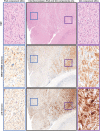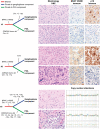Targeted Next-Generation Sequencing Reveals Divergent Clonal Evolution in Components of Composite Pleomorphic Xanthoastrocytoma-Ganglioglioma
- PMID: 35703914
- PMCID: PMC9297094
- DOI: 10.1093/jnen/nlac044
Targeted Next-Generation Sequencing Reveals Divergent Clonal Evolution in Components of Composite Pleomorphic Xanthoastrocytoma-Ganglioglioma
Abstract
Composite pleomorphic xanthoastrocytoma-ganglioglioma (PXA-GG) is an extremely rare central nervous system neoplasm with 2 distinct but intermingled components. Whether this tumor represents a "collision tumor" of separate neoplasms or a monoclonal neoplasm with divergent evolution is poorly understood. Clinicopathologic studies and capture-based next generation sequencing were performed on extracted DNA from all available PXA-GG at 2 medical centers. Five PXA-GG were diagnosed in 1 male and 4 female patients ranging from 13 to 25 years in age. Four arose within the cerebral hemispheres; 1 presented in the cerebellar vermis. DNA was sufficient for analysis in 4 PXA components and 3 GG components. Four paired PXA and GG components harbored BRAF p.V600E hotspot mutations. The 4 sequenced PXA components demonstrated CDKN2A homozygous deletion by sequencing with loss of p16 (protein product of CDKN2A) expression by immunohistochemistry, which was intact in all assessed GG components. The PXA components also demonstrated more frequent copy number alterations relative to paired GG components. In one PXA-GG, shared chromosomal copy number alterations were identified in both components. Our findings support divergent evolution of the PXA and GG components from a common BRAF p.V600E-mutant precursor lesion, with additional acquisition of CDKN2A homozygous deletion in the PXA component as is typically seen in conventional PXA.
Keywords: Collision tumor; Ganglioglioma; Intratumoral heterogeneity; Molecular neuropathology; Neurooncology; Pleomorphic xanthoastrocytoma; Precision medicine.
© The Author(s) 2022. Published by Oxford University Press on behalf of American Association of Neuropathologists, Inc. All rights reserved. For permissions, please email: journals.permissions@oup.com.
Figures



References
-
- Furuta A, Takahashi H, Ikuta F, et al. Temporal lobe tumor demonstrating ganglioglioma and pleomorphic xanthoastrocytoma components. Case report. J Neurosurg 1992;77:143–7 - PubMed
-
- Lindboe CF, Cappelen J, Kepes JJ. Pleomorphic xanthoastrocytoma as a component of a cerebellar ganglioglioma: Case report. Neurosurgery 1992;31:353–5 - PubMed
-
- Kordek R, Biernat W, Alwasiak J, et al. Pleomorphic xanthoastrocytoma and desmoplastic infantile ganglioglioma—have these neoplasms a common origin? Folia Neuropathol 1994;32:237–9 - PubMed
-
- Rao C, Abdu A, Deloso D, et al. Co-occurrence of ganglioglioma and pleomorphic xanthoastrocytoma in the temporal lobe. J Neurooncol 1995;24:125–40
-
- Powell SZ, Yachnis AT, Rorke LB, et al. Divergent differentiation in pleomorphic xanthoastrocytoma. Evidence for a neuronal element and possible relationship to ganglion cell tumors. Am J Surg Pathol 1996;20:80–5 - PubMed
Publication types
MeSH terms
Substances
Grants and funding
LinkOut - more resources
Full Text Sources
Medical
Research Materials
Miscellaneous

